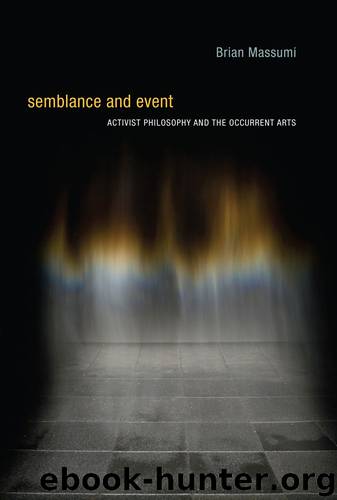Semblance and Event by Brian Massumi

Author:Brian Massumi [Massumi, Brian]
Language: eng
Format: epub
ISBN: 9780262297257
Publisher: The MIT Press
Published: 2011-03-14T16:00:00+00:00
Second Movement: Life Unlimited
Semblance of a Truth (in Depth)
Language may be the most complete archive of nonsensuous similarity, but the technique of ritual shows that it is eminently possible to activate and disseminate relation by predominately nonverbal means. It was said earlier that objective forms are the sensuous traces of essentially nonsensuous qualitative-relational experience. It follows that any differential attuning of sensuous forms to each other is a way of performing virtual events, permuting or inventing nonsensuous similarities, and producing speculatively pragmatic truths, or semblances that foretrace them. Sensuous forms may also constitute an “archive” of relational experience.
Susanne Langer treats forms as mundane as perspective painting in just this way. In a painting, “everything which is given at all is given to vision” (Langer 1953, 73). But we perceive more than we see. We see surface but perceptually feel depth. Thus there must be in the painting “visible substitutes for nonvisible ingredients in space experience”: “things that are normally known by touch or [the proprioceptive sense of] movement” (ibid.). This couching of nonvisible trace experiences in visible form can only be achieved if the artist “departs” from “direct imitation” (ibid.). The artist must falsify vision in just the right way to produce an effective inclusion in the visible of what cannot be seen. In other words, she must paint not the visible resemblances her eyes see in sensuous form, but rather the nonsensuous similarity between vision and other-sense events that yoke together amodally in movements through space. If painted with enough artifice, their linkage will be activated even in the actual absence of the movements and spaces to which they belong. The painting archives amodal, nonlocal linkages that operate through vision but are not contained by it.
Because of the necessary falsification involved, Langer calls the semblance of space an “illusion.” But she also emphasizes the extreme “artifice,” the mastery of technique, necessary to “construct” the semblance. One philosopher’s illusion is another’s produced truth. Perhaps we can halve the difference and say in this case truth-likeness. Unless and until the art-constructive process prolongs or initiates tendencies toward new path-making activity in the world, becoming political in its own inimitable aesthetic way, what it has produced remains a semblance of a truth concerning space and movement (see chapter 2).
The experience of space we feel when we view a painting, Langer emphasizes, is a real experience of space and the potential movements it affords. It’s just that the space is virtual. Visible form has been used as a local sign (James 1950, 155–165) of nonlocal linkages. The function of the local sign is catalytic. A sensuous form has activated the formation of a “created … virtual form” (Langer 1953, 172, 173). The canvas, pigment, and frame that are actually seen are the local signs hosting the semblant event.
Perspective painting is like ritual in that it produces an experience in vision of a spatialized virtual event. The virtual space of perspective painting, in contrast to ritual space, is fundamentally this-worldly, projecting a geometric formalization of the empirical order.
Download
This site does not store any files on its server. We only index and link to content provided by other sites. Please contact the content providers to delete copyright contents if any and email us, we'll remove relevant links or contents immediately.
The remains of the day by Kazuo Ishiguro(8826)
Tools of Titans by Timothy Ferriss(8219)
Giovanni's Room by James Baldwin(7193)
The Black Swan by Nassim Nicholas Taleb(7011)
Inner Engineering: A Yogi's Guide to Joy by Sadhguru(6725)
The Way of Zen by Alan W. Watts(6507)
Asking the Right Questions: A Guide to Critical Thinking by M. Neil Browne & Stuart M. Keeley(5645)
The Power of Now: A Guide to Spiritual Enlightenment by Eckhart Tolle(5607)
The Six Wives Of Henry VIII (WOMEN IN HISTORY) by Fraser Antonia(5397)
Astrophysics for People in a Hurry by Neil DeGrasse Tyson(5134)
Housekeeping by Marilynne Robinson(4348)
12 Rules for Life by Jordan B. Peterson(4250)
Double Down (Diary of a Wimpy Kid Book 11) by Jeff Kinney(4208)
The Ethical Slut by Janet W. Hardy(4174)
Skin in the Game by Nassim Nicholas Taleb(4163)
Ikigai by Héctor García & Francesc Miralles(4125)
The Art of Happiness by The Dalai Lama(4063)
Skin in the Game: Hidden Asymmetries in Daily Life by Nassim Nicholas Taleb(3930)
Walking by Henry David Thoreau(3894)
